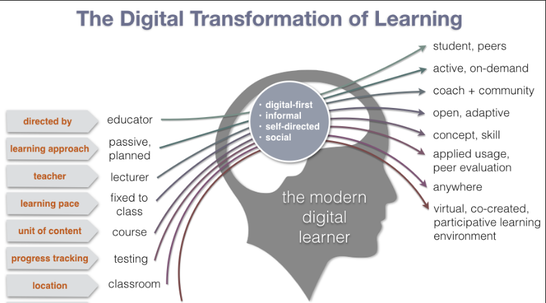- Artificial intelligence
- Robotics
- Internet of things
- Cloud storage
- Self-driving cars
- Cyber security
Importance of Digital Transformation in Education
“An investment in knowledge pays the best interest.” – Benjamin Franklin
As mentioned earlier, innovation is a prerequisite for survival in this digital world. It is no longer viable for any business, educational or otherwise, to sit back and see where this digital train goes. Core systems need to be upgraded and digital transformation needs to be incorporated in the educational sector.
Education today has become more competitive and digital alteration is needed for institutions to survive. However survival in this digital age would also mean the educators need to adapt to and accept the technologies and various changes which come with it.
One fundamental element to keep in mind is that education is not only for the young people. It does not begin and end with school life. Education and learning is a continuous process and continues well into adult life.
Source: https://www.digitalistmag.com/improving-lives/2017/10/05/education-digital-transformation-new-societal-challenge-05404388
The educational sector has seen a lot of technological changes in the past few decades where new systems, new platforms and applications have made their way into the learning process. New technologies are emerging daily and they impact the educational landscape on every level.
Students today are digital natives. Their approach to learning is very different from the previous generations. They have a plethora of technology which they are exposed to since birth and this technology is important to help bridge gaps between students and education. It also helps students with special needs to learn, understand and grasp matter in a style most suitable to them.
Technologies used in the Educational Sector
Digital transformation is allowing schools to provide anopulent educational experience that supports deeper understanding and learning to all its students. Let us have a look at a few technologies and how they are impacting the educational sector:
Internet of Things
Many institutions are adopting IoT to enable anytime, anywhere learning. Devices connected to the internet make it possible for important information to be passed on to the students. For example,
- School activities
- Homework reminders
- Group study locations
- After-school activities
- Use of digital whiteboard to pass information to student devices
- Automatic tracking of assignments
- Tests being graded and results shared in real time
Personal learning devices can also be connected to a cloud, where it becomes easier for teachers to monitor and analyse which students need help in which area.
Teachers, admin, students as well as parents can benefit from the added security measures in case of emergencies. Facial recognition, weather updates for storms and criminal activity on campus can be identified and necessary actions can be taken as needed. For example, gun violence is a rising threat and having large gates is not as effective as metal detectors to keep students safe.
Potential threats can also be monitored easily with new technology. There will be discrepancies in the type of technology being used in the various institutions, depending on budgets and other factors, however 2019 will see a lot of advancements which will be more universally acceptable.
(Source: https://www.forbes.com/sites/danielnewman/2018/11/13/top-5-digital-transformation-trends-in-education-for-2019/#266b1e705d4d)
Artificial Intelligence (AI) and Big Data
Testing is an important aspect to help educators gage a student’s performance. However, there are many other factors which can be looked into and analysed before a single score can determine a student’s abilities.
This kind of analysis is now possible with Big Data software. An individual teacher would not need to pour over endless reports or tests. Human error will also be negated in such scenarios. Unprecedented capabilities and software applications have been created for the educational industries. For example,
- E-Learning courses
- IT tools
- Chatbots
- Online tutoring
- Online enrolment and admissions
These software’s and devices make it possible for the teaching staff to focus on intricate or sensitive matter. Resources can be diverted for tasks which are of higher priority and at the same time automate the admin services being offered to students.
Augmented Reality and Virtual Reality
AR and VR technology is beneficial as students get to experience and not just hear about or read about a subject. Similar to audio-visual stimulation, AR and VR make it possible for better understanding, knowledge and retention.
Students can take field trips to different countries without actually leaving the classroom. Everything from history to science to astronomy can come to life within the class itself. This not only helps ensure students are engaged but also look forward to the educational experience.
Smart devices significantly enhance learning experiences and academic content becomes more immersive and enjoyable. For example,
- 3D rendering of a historic relic
- Walkthrough a museum
- Studying human DNA
- Personalised learning modules
- Adaptive gamification to make learning fun
Source: https://www.innovify.com/blogs/7-edtech-trends-impacting-digital-solutions-for-education-industry
In order to drive innovation and survive in a digital-centric world, it is imperative that educational institutions operate with a digital-first mindset. The millennial generation is mobile focused and within the next 5 years, more than 30 million people will use smartphones in Canada alone. Hence it is important to focus on growing digitally as the benefits far outweigh the costs.
Source: https://www.statista.com/statistics/467190/forecast-of-smartphone-users-in-canada/
Technology helps promote a feeling of independence, empowers creativity, aides in problem solving and helps teach perseverance. In the job markets today, being digitally sound is as important as being knowledgeable. Students who embrace technology automatically get a leg up and are better equipped to succeed in today’s world.
Educators need to embrace the new technology and devices as they are becoming increasingly valuable for education today. If you would like to discuss how digital transformation is the next phase in the educational sector, you can contact the App Scoop Vancouver mobile app developers team on: https://app-scoop.com/contact-us.html.







